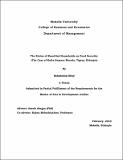| dc.description.abstract | ABSTRACT
Food security in Ethiopia has remained an unfulfilled dream for a considerable number of people for a long and continuous period of time .Resettlement program is, thus, one among different development alternatives designed and implemented by the existing government to help people from densely populated and drought prone areas as well as displaced citizens and the unemployed youth get work and live in fertile areas of the country so as to do away with the resultant problems. This being so, this research work is undertaken to critically appreciate the program by examining the food security status of resettlers in the study area ; assessing the determinants of household food security differentials ;assessing the impact of the program on the environment ; and forwarding certain suggestions for ways of improving the program should the need arise. To this end, Descriptive statistics,Aggregated Household Food Security Index (AHFSI) , food balance sheet and binary logit model were used. Both primary and secondary data were also employed in getting the necessary information for the analysis of the study. ‘Tabias’ with settlers for a relatively longer period of time and with relatively larger forest wild life were selected in order to respectively reflect the degree of food security or otherwise in households and the consequences of resettlement on environment. Sampling in each ‘Tabia’ was based on the proportion of the population in the respective ‘Tabias’. As a result, taking food poverty line (2200 kcal) as a yardstick, it was found that around 68 % (i.e., 2/3) of households in the study area are food secure while the remaining balance of 32% (i.e.,1/3) of the households are insecure. Moreover, the result was also reinforced by the fact that the resettlers are food secure (and self-sufficient) at household level witnessed by both AHFSI and food balance sheet of the Woreda. All in all, this state of affair indicates that resettled households are food secure and self sufficient in food in the areas visited for the study. The result of the logistic regression model revealed that among the fifteen variables considered in the model, four explanatory variables were found to be significant up to less than 10 % probability level. These significant variables include farm size, initial income, irrigation use and age of household heads. Identifying and understanding factors that are responsible for household food security status and its determinants is important to combat food security problems at the household level. The study findings suggest that in selecting priority intervention areas, the food security strategy should consider statistically significant variables as the most important areas. Study on development program will, however, be meaningless if it passes by without touching developments effect on environment. In a nut shell, the achieved objectives of the development program may not be sustainable if the negative environmental impacts of resettlement continue unchecked. | en_GB |


